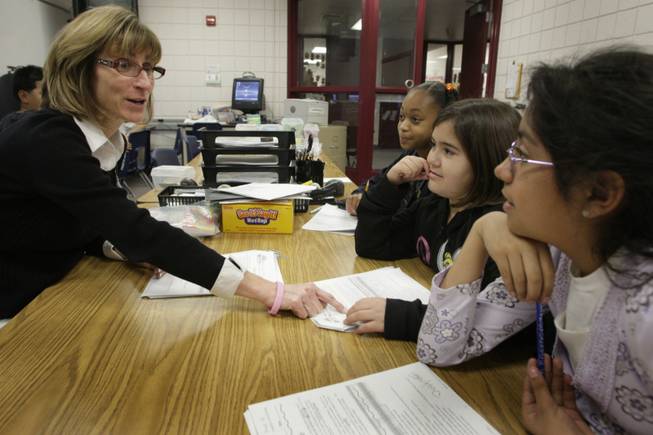
Vicki Weatherman teaches reading to fourth graders, from left, Alanna Holmes, Jennifer Lopez and Joelda Segovia at Adams Elementary, an empowerment school, in February.
Friday, July 9, 2010 | 2:01 a.m.
Campus autonomy
Empowerment schools get an increase in per-pupil funding, and the principals would get more control over daily operations, such as budgets. In exchange, the schools would be held to higher levels of accountability.
Sun coverage
Sun archives
- A comparison of the gubernatorial candidates’ education plans (7-7-2010)
- Brian Sandoval lays out education plan, backs vouchers (6-29-2010)
- Rory Reid’s reform plan: Boost education, boost economy (5-23-2010)
- School reform plans scaled back in face of budget cuts (2-11-2010)
- District announces three new empowerment schools (2-9-2009)
A new study of the Clark County School District’s “empowerment” program found strong academic achievement by many students, but made it clear that changing the management style of a campus is no silver bullet to improving performance.
When the new academic year begins in August, the district will have 30 empowerment schools, less than 10 percent of its more than 350 campuses. Although the pilot program is only in its fourth year, legislators, educators and parents have strongly praised it for its emphasis of campus autonomy. Principals have more control over staffing and budgets, and teachers often have more opportunities for professional development. Each empowerment school is paired with a private-sector partner to provide support for enrichment programs and help boost community involvement.
The first four campuses to join the program received additional funding, as did 13 schools that followed (although at a lower dollar amount per student, after the district’s money ran short). This fall, 13 empowerment schools will join the roster without a guarantee of additional funds, although money — including federal grants — might become available. The district is busy recruiting private partners to help pay for teacher bonuses that would be based heavily on student performance.
Ralph Reynolds, professor of educational psychology at UNLV and the study’s lead author, said it’s a mistake not to acknowledge that schools are complex systems, and that a host of factors affects whether students perform well. Empowerment is just one component. And there isn’t yet a blueprint for successfully implementing the model at other campuses, the study found.
“The empowerment concept has great potential,” Reynolds told the Sun on Thursday. “However, we need to verify the model before it can be implemented widely.”
Plenty of people want to see a wider implementation — both Democrat Rory Reid and Republican Brian Sandoval, who will face off in the gubernatorial race in November, have pledged to expand empowerment as part of their education plans.
In 2006, the district chose Adams, Antonello, Culley and Warren elementary schools for the pilot program based on student demographics. Along with an increase in per-pupil funding, the principals got more control over daily operations. In exchange, the schools were held to higher levels of accountability.
The study, conducted by UNLV’s Center for Evaluation and Assessment, found that as a group, students in grades 3 and 5 at the four original empowerment campuses significantly outperformed their peers at demographically similar schools in reading and mathematics.
But those gains might be attributed to elements other than the school’s empowerment status, Reynolds said, and empowerment did not have the same effect on each campus. Because no two schools started at the same point in student achievement, and no two schools implemented empowerment in exactly the same way, comparisons are tricky, Reynolds said.
Researchers found the leadership style of a principal could have a significant effect on student performance. Schools where the staff “buys in” to the principal’s methodology, and when that methodology was based on sound research, can mean better classroom instruction and stronger gains by students, Reynolds said.
And empowerment schools may need more than one leader.
“You might have to have one kind of principal to lead the innovation and one to manage and sustain the innovation,” Reynolds said. “It’s not necessarily the same person.”
The study’s findings give the district a good starting point for developing a more precise picture of potential empowerment principals, said Sue Daellenbach, assistant superintendent of assessment and accountability.
“This doesn’t mean we have to go out and pick one kind of person,” Daellenbach said. “But at least we have a framework for what we’re looking for in terms of leadership and organization.”
Reid has said if elected governor, he wants to create a network of schools that would operate similarly to the district’s empowerment model, and eventually every campus in the state would follow the same format.
Reynolds said he thinks empowerment might work as a mandatory model — rather than something school communities choose to adopt, as is currently the case in Clark County. But, he added, there would need to be sufficient training and support. And the professional development would need to extend to teachers, who must be fully engaged in the empowerment model for it to work.
“This isn’t something you can just drop down onto people and expect them to be successful,” said Reynolds, who presented his findings to the School Board on Thursday. “It’s much more complicated than that.”
Robert McCord, an associate professor of educational leadership at UNLV, noted that plenty of outstanding schools in Clark County are not operating under the empowerment model.
“How the daily operations are carried out is not the only variable,” McCord said. “It’s a contributing factor, but you have to have the right combination of strong personnel who follow through, and a community that stands behind the school and supports its students.”


Join the Discussion:
Check this out for a full explanation of our conversion to the LiveFyre commenting system and instructions on how to sign up for an account.
Full comments policy